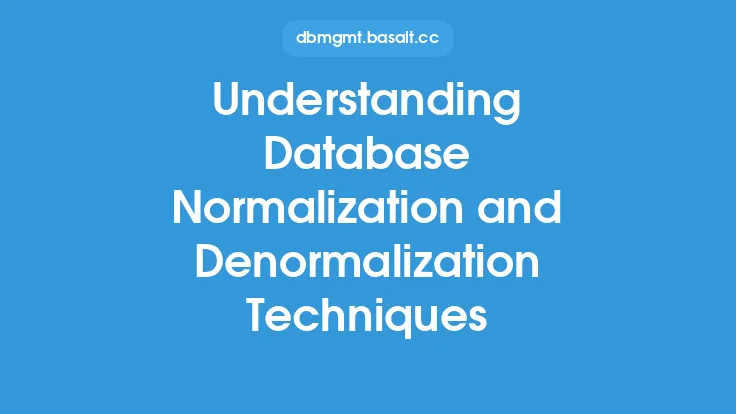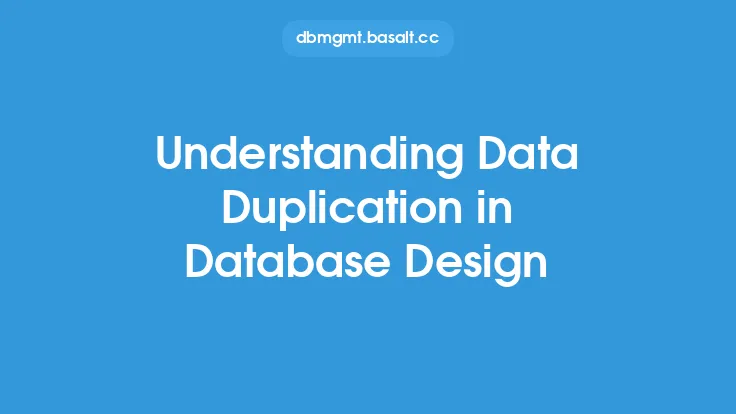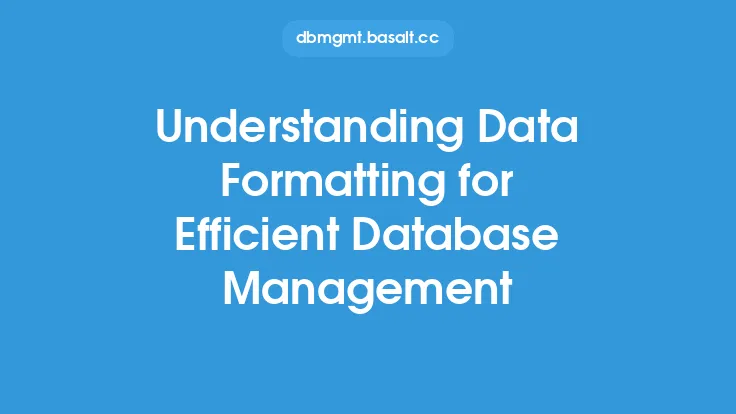Database normalization is a fundamental concept in database design that ensures data consistency, reduces data redundancy, and improves data integrity. It is a process of organizing data in a database to minimize data duplication and dependency, making it easier to maintain and scale. Normalization involves dividing large tables into smaller, more manageable tables, and linking them through relationships. This process helps to eliminate data anomalies, such as insertion, update, and deletion anomalies, which can occur when data is not properly normalized.
Introduction to Normalization Rules
There are several normalization rules, each with its own set of guidelines for organizing data. The most common normalization rules are:
- First Normal Form (1NF): Each table cell must contain a single value, and each column must contain only atomic values.
- Second Normal Form (2NF): Each non-key attribute in a table must depend on the entire primary key, not just one part of it.
- Third Normal Form (3NF): If a table is in 2NF, and a non-key attribute depends on another non-key attribute, then it should be moved to a separate table.
- Boyce-Codd Normal Form (BCNF): A table is in BCNF if and only if it is in 3NF, and there are no transitive dependencies.
- Higher Normal Forms: There are additional normalization rules, such as 4NF, 5NF, and 6NF, which deal with more complex data relationships.
Benefits of Normalization
Normalization offers several benefits, including:
- Reduced data redundancy: Normalization eliminates data duplication, which reduces storage requirements and improves data consistency.
- Improved data integrity: Normalization ensures that data is consistent across the database, reducing errors and inconsistencies.
- Improved scalability: Normalization makes it easier to add new data or modify existing data, without affecting the entire database.
- Simplified maintenance: Normalization makes it easier to maintain the database, as changes can be made to a single table, rather than multiple tables.
- Improved data security: Normalization helps to protect sensitive data, by storing it in separate tables, and controlling access to those tables.
Normalization Techniques
There are several normalization techniques, including:
- Eliminating repeating groups: Repeating groups, such as arrays or lists, can be eliminated by creating a separate table, with a foreign key that links back to the original table.
- Eliminating partial dependencies: Partial dependencies, where a non-key attribute depends on only one part of the primary key, can be eliminated by creating a separate table, with a foreign key that links back to the original table.
- Eliminating transitive dependencies: Transitive dependencies, where a non-key attribute depends on another non-key attribute, can be eliminated by creating a separate table, with a foreign key that links back to the original table.
Denormalization
Denormalization is the process of intentionally violating normalization rules, to improve performance or reduce complexity. Denormalization can be used to:
- Improve query performance: Denormalization can improve query performance, by reducing the number of joins required to retrieve data.
- Reduce complexity: Denormalization can reduce complexity, by eliminating the need for complex joins or subqueries.
- Support data warehousing: Denormalization can support data warehousing, by providing a simplified data structure, that is optimized for querying and analysis.
Best Practices for Normalization
There are several best practices for normalization, including:
- Start with a conceptual data model: A conceptual data model, such as an entity-relationship diagram, can help to identify the key entities and relationships in the database.
- Use a systematic approach: A systematic approach, such as the normalization rules, can help to ensure that the database is properly normalized.
- Consider data redundancy: Data redundancy, such as duplicate data, can be eliminated through normalization.
- Consider data integrity: Data integrity, such as ensuring that data is consistent across the database, can be improved through normalization.
- Consider scalability: Scalability, such as the ability to add new data or modify existing data, can be improved through normalization.
Common Normalization Mistakes
There are several common normalization mistakes, including:
- Over-normalization: Over-normalization, where data is split into too many tables, can lead to complexity and performance issues.
- Under-normalization: Under-normalization, where data is not split into enough tables, can lead to data redundancy and integrity issues.
- Incorrect use of foreign keys: Incorrect use of foreign keys, such as using a foreign key to link to a non-key attribute, can lead to data inconsistencies and errors.
- Ignoring data relationships: Ignoring data relationships, such as many-to-many relationships, can lead to data inconsistencies and errors.
Conclusion
Database normalization is a critical concept in database design, that ensures data consistency, reduces data redundancy, and improves data integrity. By following the normalization rules, and using a systematic approach, database designers can create a well-structured database, that is scalable, maintainable, and secure. While denormalization can be used to improve performance or reduce complexity, it should be used judiciously, and with a clear understanding of the trade-offs involved. By avoiding common normalization mistakes, and following best practices, database designers can create a robust and efficient database, that supports the needs of the organization.





